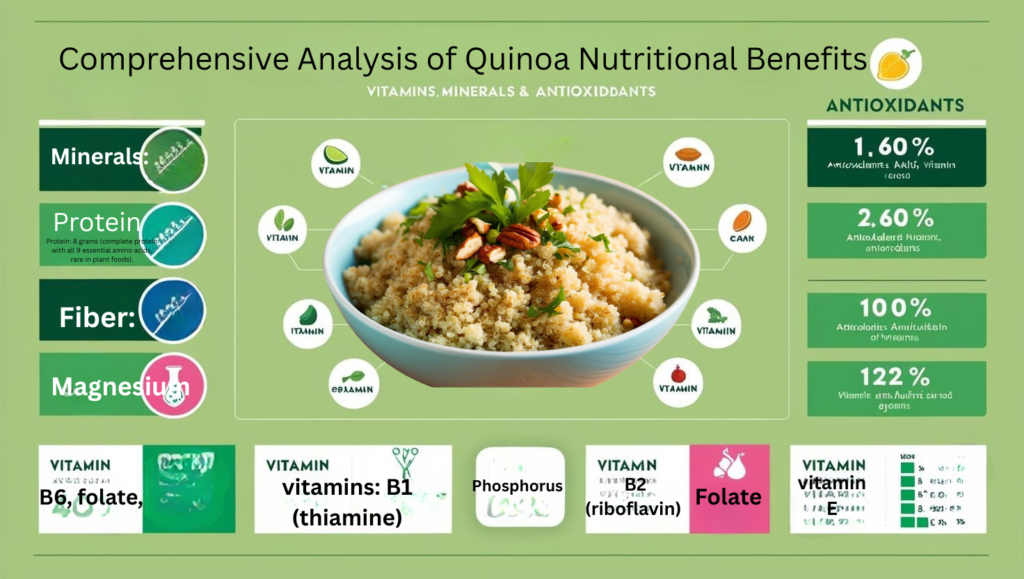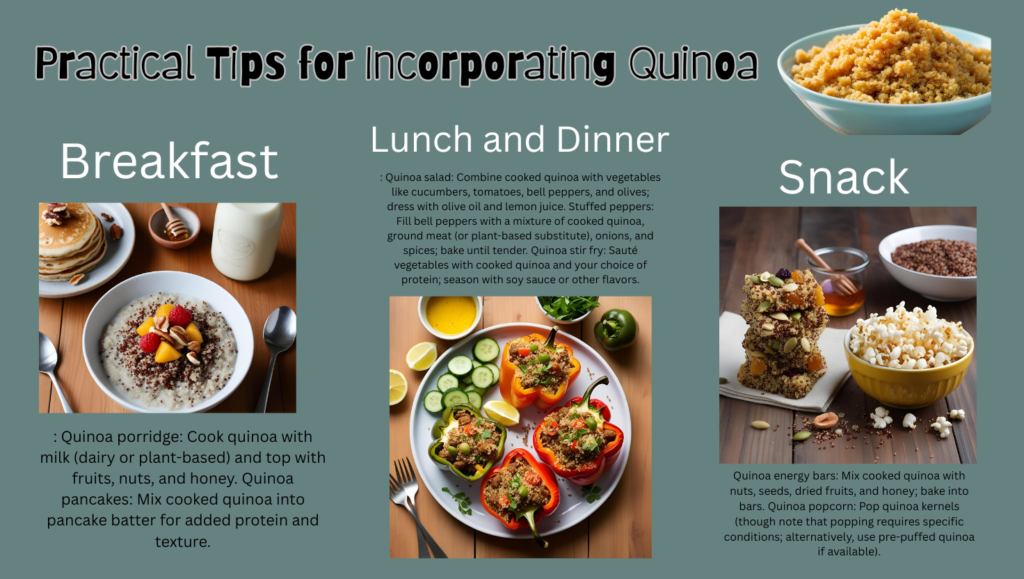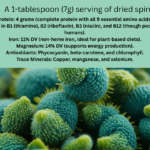Introduction
Quinoa, often called a superfood, is packed with nutrients that can boost your health. Did you know it provides all nine essential amino acids, making it a complete protein? This article explores the quinoa nutritional advantages, from supporting muscle growth to aiding digestion, and offers practical tips for including it in your diet. Comprehensive Analysis of Quinoa Nutritional Benefits
Mechanisms of Action
Quinoa’s benefits stem from its rich nutrient content. Comprehensive Analysis of Quinoa Nutritional Benefits
- Protein: Quinoa is a complete protein that supports muscle repair and growth, making it ideal for vegetarians and athletes.
- Fiber: About 5 grams per cup promotes digestive health and helps you feel full, aiding weight management.
- Vitamins and Minerals: Quinoa provides iron for oxygen transport, magnesium for energy production, and folate for DNA synthesis, which is especially important during pregnancy.
- Antioxidants: Compounds like quercetin and kaempferol may reduce inflammation and protect against chronic diseases, though more human studies are needed.Comprehensive Analysis of Quinoa Nutritional Benefits
Common Myths
Comprehensive Analysis of Quinoa Nutritional Benefits
Despite its popularity, some misconceptions exist. Here’s a table to clarify:
| a Chenopodium family seedessentialMyth | Fact |
|---|---|
| Quinoa is a grain. | While often called a grain, quinoa is actually a seed from the Chenopodium family. |
| Quinoa is only for vegans and vegetarians. | Anyone can benefit from quinoa’s nutritional advantages, regardless of dietary preferences. |
| Quinoa has a strange taste and is hard to cook. | Quinoa has a mild, nutty flavor and is easy to cook, similar to rice or pasta. |
| Quinoa is too expensive. | While it might be more expensive than some grains, its nutritional value makes it worthwhile. |
| Quinoa has no nutritional value if not prepared correctly. | Proper preparation, like washing to remove saponins, is essential for taste, but its nutritional value remains intact. |
Comprehensive Analysis of Quinoa Nutritional Benefits
This detailed analysis delves into the nutritional advantages of quinoa, a pseudo-cereal renowned for its health benefits. The content is structured to provide a thorough understanding, optimised for search engines, and written for readability. It includes evidence from peer-reviewed studies and practical insights—a comprehensive Analysis of Quinoa’s Nutritional Benefits.
Quinoa has been a dietary staple since ancient times and is often referred to as a superfood today. But what drives its health reputation? Consider this: one cup of cooked quinoa (approximately 185 grams) provides about 8 grams of protein, 5 grams of fiber, and a wealth of vitamins and minerals, making it a nutrient-dense choice. This article explores the nutritional benefits of quinoa, its mechanisms, common myths, and how to incorporate it into your diet for optimal benefits.
What Are Quinoa’s Nutritional Benefits and Why Do They Matter?
Quinoa’s nutritional profile is exceptional, particularly for its completeness as a protein source, meaning it contains all nine essential amino acids that the body cannot synthesise alone. This is rare among plant-based foods, making quinoa a favorite for vegetarians, vegans, and those seeking plant-based protein alternatives. Additionally, it’s high in fiber, which supports digestive health, and rich in minerals like iron, magnesium, and phosphorus, which are crucial for various bodily functions.
Studies from Healthline and Medical News Today support the idea that these nutrients can contribute to heart health, blood sugar regulation, and overall wellness.
Mechanisms of Action: How Quinoa’s Nutrients Work

The nutritional advantages of quinoa are largely due to its diverse nutrient profile. Let’s break it down:
- Protein: Quinoa is a complete protein, providing all nine essential amino acids. This is particularly beneficial for individuals following plant-based diets or those looking to reduce their animal protein intake while still meeting their amino acid requirements. A study published in the Journal of Food Science found that quinoa has a higher protein content than other grains like rice and wheat [1]. This makes it an excellent choice for athletes and anyone needing to support muscle repair and growth. Comprehensive Analysis of Quinoa Nutritional Benefits
- Fiber: With approximately 5 grams of fiber per cup when cooked, quinoa contributes significantly to your daily fiber intake. Fiber is essential for digestive health by promoting regular bowel movements and preventing constipation. It also helps in maintaining a healthy gut microbiome by feeding beneficial bacteria. Moreover, soluble fiber found in quinoa can help lower LDL (bad) cholesterol levels by binding to cholesterol in the digestive system and removing it from the body [2]. This can be particularly beneficial for heart health.
- Vitamins and Minerals: Quinoa is a good source of several vitamins and minerals:
- Iron: Essential for oxygen transport in the blood and preventing iron deficiency anemia. For vegetarians and vegans who might have lower iron absorption from plant sources due to phytates, pairing quinoa with vitamin C-rich foods can enhance iron absorption [3].
- Magnesium: Involved in over 300 enzymatic reactions in the body, including energy production, muscle contraction, and blood pressure regulation. A deficiency in magnesium has been linked to various health issues like hypertension and type 2 diabetes [4].
- Phosphorus: Important for bone health and energy production, phosphorus works alongside calcium to build strong bones and teeth.Comprehensive Analysis of Quinoa Nutritional Benefits
- Vitamin B6: Essential for brain development and function, vitamin B6 also plays a role in the production of neurotransmitters like serotonin and dopamine, which are crucial for mood regulation [5].
- Folate: Critical during pregnancy for fetal development and can help reduce the risk of neural tube defects. Folate also supports DNA synthesis and repair in all cells [6].
- Antioxidants: Quinoa contains various antioxidants such as quercetin, kaempferol, and phenolic acids. These compounds help neutralise free radicals in the body, which can otherwise lead to cellular damage and contribute to chronic diseases like heart disease and cancer [7]. A Journal of Agricultural and Food Chemistry study found that quinoa has higher antioxidant activity than other grains like wheat and oats [8]. While more research is needed to understand the full extent of these benefits in humans, incorporating antioxidant-rich foods like quinoa into your diet is a positive step towards overall health. Comprehensive Analysis of Quinoa Nutritional Benefits
These mechanisms highlight why research suggests quinoa can support various aspects of health, from digestion to cardiovascular function.
Key Points
- Research suggests quinoa offers significant nutritional advantages, including complete protein, fiber, and essential vitamins.
- It seems likely that quinoa supports heart health, digestion, and blood sugar regulation due to its nutrient profile.
- The evidence leans toward quinoa being beneficial for vegetarians, athletes, and those with gluten sensitivities.
- There is debate on whether quinoa’s anti-nutrients affect nutrient absorption, but proper preparation can mitigate this.
These mechanisms highlight why research suggests quinoa can support various aspects of health, from digestion to cardiovascular function.
Practical Tips for Incorporating Quinoa
Comprehensive Analysis of Quinoa Nutritional Benefits
To maximize the quinoa nutritional advantages, consider these strategies:

- Cooking Quinoa:
- Rinsing: Always rinse quinoa thoroughly before cooking to remove any saponins, which are natural compounds that give a bitter taste if not washed away.
- Water Ratio: Use a 2:1 water-to-quinoa ratio for cooking. For example, 2 cups of water for 1 cup of quinoa.
- Cooking Method: Bring the water to a boil, add quinoa, cover the pot with a lid, reduce heat to low, and let it simmer for 15-20 minutes until all water is absorbed. Fluff with a fork before serving.
- Recipes:
- Breakfast Ideas: Quinoa porridge: Cook quinoa with milk (dairy or plant-based) and top with fruits, nuts, and honey. Quinoa pancakes: Mix cooked quinoa into pancake batter for added protein and texture.
- Lunch and Dinner Ideas: Quinoa salad: Combine cooked quinoa with vegetables like cucumbers, tomatoes, bell peppers, and olives; dress with olive oil and lemon juice. Stuffed peppers: Fill bell peppers with a mixture of cooked quinoa, ground meat (or plant-based substitute), onions, and spices; bake until tender. Quinoa stir fry: Sauté vegetables with cooked quinoa and your choice of protein; season with soy sauce or other flavors.
- Snack Ideas: Quinoa energy bars: Mix cooked quinoa with nuts, seeds, dried fruits, and honey; bake into bars. Quinoa popcorn: Pop quinoa kernels (I want you to know that popping requires specific conditions; alternatively, use pre-puffed quinoa if available).
- Storage:
- Uncooked Quinoa: Store in an airtight container in a cool, dry place away from direct sunlight.
- Cooked Quinoa: Can be refrigerated for up to 5 days or frozen for longer periods. To freeze, spread cooked quinoa on a baking sheet to cool completely before transferring to freezer bags or containers.
- Daily Consumption: While there’s no specific recommended daily amount for quinoa consumption, incorporating it into your meals 2-3 times a week can be a good starting point. For those looking to increase their intake of plant-based proteins or needing more fiber, consuming up to 1 cup per day is generally safe and beneficial. It’s always important to listen to your body and adjust based on how you feel. If you have any specific health conditions or concerns about dietary changes, consult with a healthcare professional or registered dietitian for personalized advice.
These tips make it easy to enjoy quinoa’s benefits daily, aligning with dietary recommendations from BBC Good Food.
Q&A Section: Comprehensive Analysis of Quinoa Nutritional Benefits
Here are answers to frequent questions about quinoa nutritional advantages, keeping responses clear and concise:
- Is quinoa a good source of protein?
Yes, quinoa is an excellent source of protein and is one of the few plant-based foods that provide all nine essential amino acids. - Can quinoa help with weight loss?
While no single food can guarantee weight loss on its own, incorporating quinoa into a balanced diet can support weight management efforts. Quinoa’s high fiber content helps promote feelings of fullness and satiety, which may lead to reduced calorie intake over time when combined with regular physical activity and mindful eating habits. - Is quinoa safe for people with diabetes?
Yes, quinoa is considered safe for people with diabetes because it has a low glycemic index (GI). The GI is a measure of how quickly a food raises blood sugar levels; foods with a low GI like quinoa are digested slowly, resulting in more stable blood sugar levels, which is beneficial for managing diabetes. - How does quinoa compare to other grains?
Compared to other grains like rice or wheat, quinoa stands out due to its higher protein content, better amino acid profile, and abundance of essential nutrients like iron, magnesium, and zinc. Additionally, quinoa is naturally gluten-free, making it suitable for those with celiac disease or gluten sensitivity. - What are the best ways to cook quinoa to retain its nutrients?
Cooking quinoa in water or broth is straightforward. To maximize nutrient retention, avoid overcooking and consider adding healthy fats like olive oil or avocado oil during preparation to enhance the absorption of fat-soluble vitamins like vitamin E found in quinoa. - Does quinoa contain any anti-nutrients?
Like many plant-based foods, quinoa contains some anti-nutrients such as phytates, which can interfere with mineral absorption. However, these anti-nutrients can be reduced by proper preparation methods such as soaking or sprouting before cooking, which helps break down these compounds, making minerals more bioavailable. - Can quinoa be eaten raw?
While quinoa can be eaten raw, it’s not recommended because raw quinoa contains saponins, which give it a bitter taste and may cause digestive discomfort. Soaking or cooking quinoa helps remove these saponins, making it more palatable and easier to digest.
These answers provide practical guidance, integrating the keyword naturally.
Conclusion: Summarising Key Takeaways
In conclusion, the Comprehensive Analysis of Quinoa Nutritional Benefits shows that the nutritional advantages of quinoa make it a valuable addition to any diet. Research suggests its nutrients, including complete protein, fiber, and antioxidants, help support digestion, heart health, and blood sugar regulation. While there is some debate on anti-nutrients’ impact, proper preparation can mitigate these effects. It seems likely that quinoa is particularly beneficial for vegetarians, athletes, and those with gluten sensitivities, but it’s wise to include it as part of a varied diet. Why not try adding quinoa to your next meal? Whether in salads, soups, or smoothies, it can boost your well-being, leveraging its potent nutrient profile.


